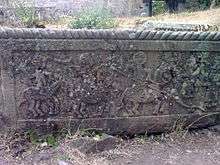Mkhitar Sparapet
Mkhitar Sparapet (Armenian: Մխիթար Սպարապետ; Sparapet meaning "general", "constable" or rather "supreme commander of the armed forces") (?-1730) was an 18th-century Armenian national hero and participant in the struggle for preserving the Armenian heritage in the Zangezur region of Transcaucasia. He was instrumental in David Bek's victories over the forces of Safavid Iran and the Ottoman Empire in Armenia's Zangezur region. Their main headquarters were at the fortress of Halidzor which also served as the administrative center for Syunik. Mkhitar served as chief aide to Bek and later his successor after his death in 1728.

Mkhitar Sparapet Մխիթար Սպարապետ | |
|---|---|
| Born | ? |
| Died | 1730 Murdered by Armenian villagers of Khndzoresk. |
| Buried | A tomb in a gorge near Nerkin Khndzoresk and Old Khndzoresk. |
| Allegiance | Armenian national movement |
| Years of service | 1722/5-1728; 1728-1730 |
| Rank | Sparapet |
In 1730, Mkhitar was murdered by Armenian villagers of Khndzoresk, who had implored him to have his own fortifications destroyed during his conflicts rather than their village. His head was presented to the Ottoman Pasha at Tabriz, who found this act of treachery detestable and had the murderers decapitated. The tomb of Mkhitar Sparapet is located in a gorge not far from Nerkin Khndzoresk and Old Khndzoresk.
Mkhitar's death sealed the fate of the Armenian liberation struggle.[1]
Popular culture
Mkhitar was one of the characters of the Soviet "David Bek" film of 1944. Another movie, made in 1978 by Armenfilm and Mosfilm, bore the name of Mkhitar Sparapet and enjoyed success in the Soviet Republic of Armenia.
References
- Adalian 2010, pp. 250-251.
Sources
- Adalian, Rouben Paul (2010). Historical Dictionary of Armenia (2 ed.). Scarecrow Press. ISBN 978-0810874503.CS1 maint: ref=harv (link)
- Kiesling, Brady (2005), Rediscovering Armenia: Guide, Yerevan, Armenia: Matit Graphic Design Studio
- Brady Kiesling, Rediscovering Armenia, p. 96; original archived at Archive.org, and current version online on Armeniapedia.org.